– The Department of Energy increased its share of the costs to study a carbon capture proposal at the San Juan Generating Station in the final week of the Trump administration.
– Enchant has focused its spending on lobbyists for additional subsidies from Congress, federal agencies, and the state of New Mexico.
– Environmental and Native groups say the federal government must complete an Environmental Impact Statement before continuing to fund the carbon capture proposal.
The developers of a controversial coal carbon capture proposal at the San Juan Generating Station in New Mexico have not attracted interest from outside investors and failed to fund even their share of the study for the billion dollar proposal. Documents obtained under the Freedom of Information Act show that the Department of Energy revised the cost sharing agreement in January 2021 to increase the share paid by taxpayers for the study; the agency now has confirmed to the Energy and Policy Institute that the decision was made during the final week of the Trump administration.
In the absence of investor interest, Enchant Energy is now also seeking a $906 million loan guarantee from the Department of Energy for the carbon capture proposal, lobbying Congress for expanded 45Q tax credits and other subsidies, and urging the state of New Mexico to accept long-term liability for sequestered carbon dioxide – on top of the federal funding it is already receiving for the study. Environmental and Native groups in the region wrote to Energy Secretary Jennifer Granholm and other officials in May to request that the agency stop spending federal dollars on the carbon capture proposal until it completes an Environmental Impact Statement.
Meanwhile, the proposal faces numerous major challenges, from water supply risks to transmission access, and New Mexico Speaker of the House Brian Egolf reminded the developers and legislators last month that the problems and delays facing the carbon capture proposal mean that the San Juan Generating Station will likely need to close as scheduled by next year to comply with the state’s Energy Transition Act.
Enchant Energy has spent far less than its expected share for carbon capture study
Enchant Energy is proposing to build the world’s largest carbon capture project at the San Juan Generating Station, a coal plant near Farmington, New Mexico. But as the Albuquerque Journal reported in June, the proposal “is facing yearslong delays in nearly all its plans, spurring renewed debate on whether the project will ever get off the ground.”
PNM, the operator of the power plant and largest utility in the state, plans to close the 50-year-old coal plant next year and replace it with renewable energy and battery storage projects. But Enchant Energy and the municipal utility for the city of Farmington, which owns a portion of the plant, want to fully acquire the plant, continue operating it, and retrofit it with a massive carbon capture project and carbon dioxide pipeline. In 2019, the Department of Energy provided a grant to Enchant Energy to help fund a Front-End Engineering and Design (FEED) study about the proposal, as part of a broader effort by the Trump administration to fund coal and gas power plant carbon capture proposals.
A cost sharing agreement between Enchant Energy and the Department of Energy (DOE) suggest that the parties expected that Enchant Energy would provide the majority of the funding for the FEED study, according to DOE documents.
In a presentation to the DOE in August 2020, Enchant Energy executives included a table showing that the federal share for the FEED study was expected to amount to 36% of the total spending, with private parties covering the remaining 64%. A note under the funding table explains: “Until DOE receives verification of 100% of the Recipient’s cost share contribution, only $503,384 of DOE funding is available for work performed by the Recipient.”
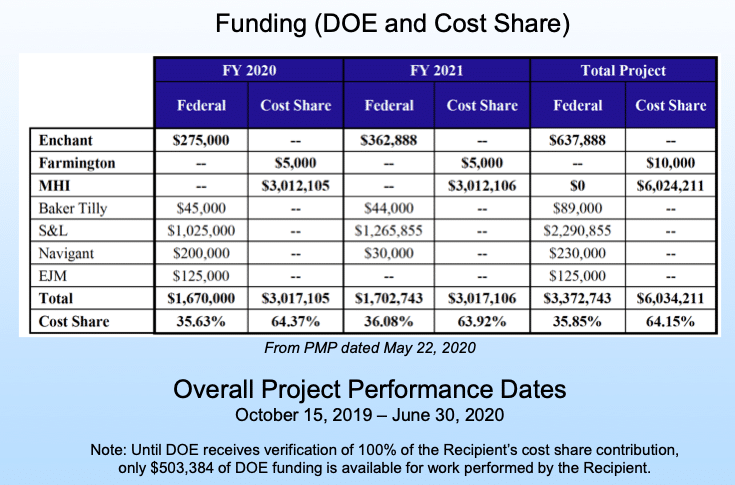
But a review of the quarterly reports submitted by Enchant Energy to the Department of Energy shows that Enchant Energy has spent far less than expected, while the Department of Energy has paid for 80% of the total spent on the FEED project. Those reports and other documents were obtained from DOE under the Freedom of Information Act by the San Juan Citizens Alliance and EPI.
In a quarterly report submitted to the Department of Energy for the last three months of 2020, Enchant Energy noted that “Enchant’s share of expenditures reported as of 12/31/2020 is below the 64.15% cost share commitment and is less than planned.”
In fact, Enchant Energy’s share of the spending was nowhere close to expectations; its share of spending on the study by the end of 2020 was just $198,350, a small fraction of the $5.1 million originally expected by that point. Instead of spending 64% of the total as expected, Enchant had only spent 15%, while the Department of Energy had paid 85%.
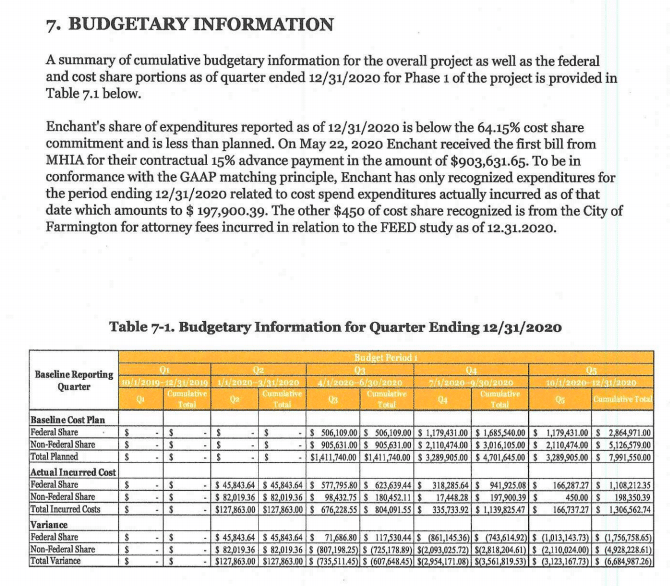
Enchant Energy’s next quarterly report included an updated version of that budget table, but with a much lower figure for the expected spending by Enchant: $917,965 instead of the $5.1 million in the previous report. The budget table in the most recent report, submitted to the Department of Energy on July 31, shows an even lower figure: $450,991. The reports do not explain why the expected amount of spending kept decreasing. For both of those quarterly reports, Enchant Energy’s actual spending was 20% of the total, while the Department of Energy covered 80%.
Both of those two most recent quarterly reports include the same note about the budget tables: “Please note that the budgetary information is based on the revised cooperative agreement that was definitized in January of 2021.”
A redacted version of that January 2021 amendment to the agreement between Enchant Energy and the Department of Energy shows that the agreement was extended by six months, and that “the government share is hereby increased by [redacted] the cost share amount is hereby decreased by [redacted].”
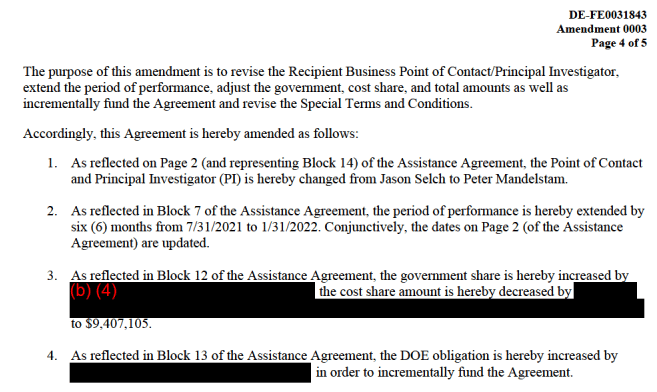
That document does not include a date, but a spokesperson for the Department of Energy told EPI on August 18 that the agreement was revised on January 12. So the decision to extend the agreement and increase the federal government’s share of spending on the San Juan coal carbon capture project study was made during the final week of the Trump administration.
Investors appear uninterested in the San Juan coal carbon capture proposal
Enchant Energy’s quarterly reports to the Department of Energy mention the company’s struggles to attract investors, though without providing details.
The report for the first quarter of 2021 mentioned that “Several factors occurred with the investor that delayed closing on the financing which impacted Enchant’s ability to fund its full cost share obligation as previously submitted to the DOE in January 2021.” The report doesn’t explain what “factors” occurred with the potential investor.
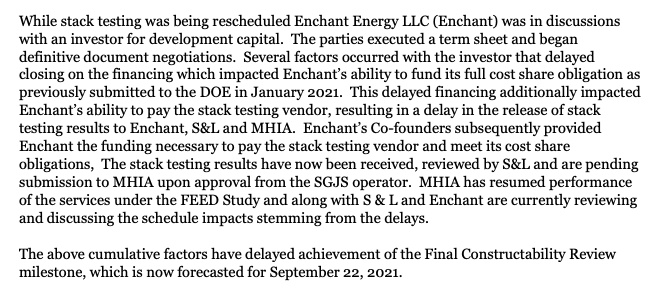
The most recent quarterly report noted in a section about problems facing the study that “third-party development financing delays impacted the FEED Study PMP (project management plan), schedule and milestones from what was submitted in January 2021.”
Without interest from outside investors, Enchant Energy has shifted to seeking support from the Department of Energy Loan Programs Office. Enchant Energy CEO Cindy Crane told the Albuquerque Journal in June that “We’ve had conversations with the DOE pre-Biden and post-Biden, but we held off on filing until Biden folks were in place. We were in Washington, D.C. just two weeks ago to meet with DOE loan program folks.”
It’s not clear whether the Department of Energy will expand its support of the proposal. The head of the Department of Energy’s Office of Fossil Energy and Carbon Management, Dr. Jennifer Wilcox, explained in April: “The office has invested a great deal of time and resources in CCS on coal. And it’s clear that carbon capture may not make economic sense on the remaining existing fleet of coal fired power plants in the United States, plants that are mostly based on subcritical efficiency boilers and nearing retirement over the next decade.” Dr. Wilcox said carbon capture efforts should focus on industrial sectors and newer gas plants.
Environmental and Native groups seek Environmental Impact Statement
Environmental and Native groups in the region say that the National Environmental Policy Act (NEPA) requires that the federal government complete an Environmental Impact Statement (EIS) before making any decision about a loan guarantee or other additional funding for the San Juan carbon capture proposal.
In a May 21 letter to Energy Secretary Jennifer Granholm and other officials, the groups explained:
The potential environmental impacts resulting from the existing federal grants and potential loans is enormous and currently unvetted. The proposed projects would involve a complete redesign of a large coal-fired power plant, a life extension of the power plant and related air pollution emissions, the construction and development of CO2 injection wells and an underground sequestration site, pipeline(s) construction, and development of existing oil resources using EOR. It is our understanding that neither of the existing grants was issued following a NEPA review, and as noted, there is as yet no NEPA consultation underway for related federal loans/nexuses.
We ask that DOE, USDA and NETL halt any further funding and segmentation of these projects and instead immediately commence a full and complete multi-agency EIS review process under NEPA whereby the environmental impacts of the work completed via federal grants, potential loans and reasonably foreseeable future actions for the entire complex proposed by Enchant are fully evaluated. Our organizations expect to be apprised of any and all public involvement opportunities as required by NEPA and associated regulations including Environmental Justice analyses and consultation under the National Historic Preservation Act.
The letter was signed by representatives of the San Juan Citizens Alliance, Diné C.A.R.E., Tó Nizhóní Ání, NAVA Education Project, National Parks Conservation Association, Western Environmental Law Center, 350 New Mexico, Sierra Club Rio Grande Chapter, and the Center for Biological Diversity.
Nearly three months later, the groups have not received a response from Secretary Granholm or other officials, according to Mike Eisenfeld, Energy and Climate Program Director for the San Juan Citizens Alliance.
A Department of Energy spokesperson told EPI on August 18: “The current project is only for a Front End Engineering Design (FEED) study and the NEPA is a categorical exclusion. A FEED study does not involve any construction, and that is why a categorical exclusion applies. If the project gets more DOE funding another NEPA will be conducted. The decision if it will be an Environmental Assessment (EA) or Environmental Impact Statement (EIS) will be made at that time.”
The Department of Energy completed Environmental Impact Statements for other major carbon capture projects it funded, including the Petra Nova project, the Kemper project, both FutureGen projects, and several others.
“Enchant’s projection that it will close on this new funding by the end of 2021 is unrealistic,” said David Schlissel, director of resource planning analysis at IEEFA, which published a report about the San Juan coal carbon capture project in May. “The DOE took almost three years to fund $190 million of the now-defunct Petra Nova carbon capture project, and Enchant is asking for nearly five times that amount to be used in about a third of the time.”
Enchant Energy seeks more subsidies from New Mexico legislature and US Congress
In addition to the Department of Energy funding for the FEED study and applying for a loan guarantee, Enchant Energy is also seeking additional subsidies and support from both the New Mexico legislature and US Congress.
In a presentation last month to the New Mexico Legislature Water and Natural Resources Committee, Enchant Energy executives proposed new state legislation that would transfer long-term liability for sequestered carbon dioxide from Enchant Energy to the state of New Mexico. Enchant Energy executives tried to characterize that proposal as “very modest legislation” and argued “No private entity could bear the burden. There’s a concern that the long-term liability is just not supportable by the private insurance industry.”
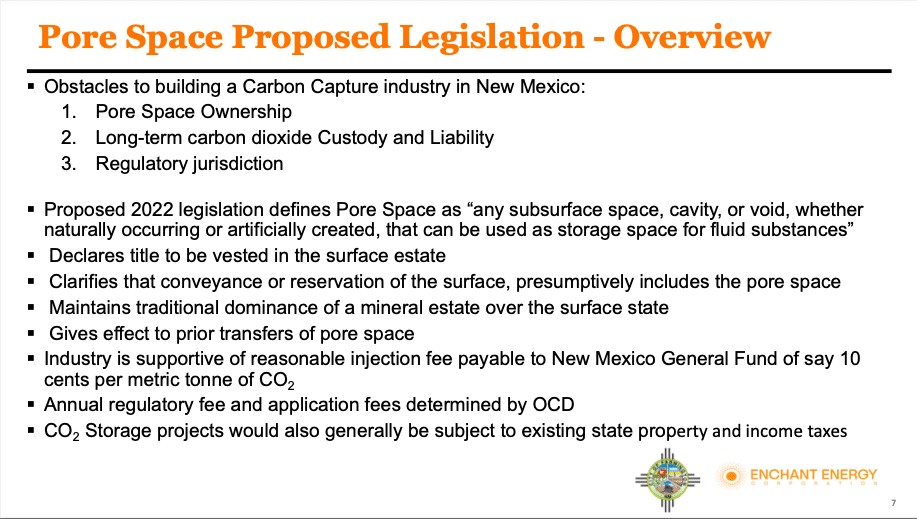
The presentation also notes that the “City of Farmington has submitted request to U.S. Congress for community project funding for this deferred maintenance” at the San Juan Generating Station amounting to $139 million.
Enchant Energy is also seeking a $90 million loan from the US Department of Agriculture Rural Utilities Service.
Finally, that presentation explains that “Enchant is active in Federal legislative efforts to further enhance Section 45Q Carbon Capture Tax Credits (lengthening 45Q duration, and 45Q value per metric tonne) which would enable operating the plant beyond 2037, possibly to 2045.”
Lobbying disclosure records show that Enchant Energy spent $630,000 in 2020 and 2021 on lobbyists with Sidley Austin LLP, including former Illinois Republican Congressman Peter Roskam. Enchant Energy’s spending on federal lobbying exceeds the $398,672 it has spent on the FEED study, while the Department of Energy spent more than $1.5 million.
Carbon capture at San Juan Generating Station faces more challenges
As Enchant Energy seeks federal and state support for its carbon capture proposal, the company faces several major challenges.
A cooling tower at the San Juan Generating Station collapsed on June 30, taking one of the coal units offline and leading to hearings and an investigation by the New Mexico Public Regulatory Commission.
Adding carbon capture to the plant would significantly increase water consumption from the San Juan River, while the region suffered from extreme or exceptional drought conditions for most of this summer; in June the city of Farmington asked residents to reduce their water use.
A bigger challenge may be a lack of available transmission from the coal plant. S&P Global reported that the transfer of the plant from PNM to Enchant Energy and Farmington “remains in limbo after two years of unsuccessful negotiations,” according to PNM spokesperson Ray Sandoval:
But even if the ownership transfers go through, the San Juan plant will no longer have immediate access to PNM’s transmission lines a year from now. The utility retains the rights to that infrastructure, and Sandoval indicated that PNM needs the capacity on those lines to transmit power to its customers in New Mexico urban areas from the solar farms that will replace the output of the San Juan plant.
“They say they will operate without carbon capture, but what transmission are they going to use?” Sandoval said. “It’s like we’re living in a twilight zone.”
Finally, Enchant Energy’s plan to continue operating the San Juan Generating Station for years without any carbon capture would violate the Energy Transition Act, New Mexico’s key climate and clean energy law. New Mexico Speaker of the House Brian Egolf, who helped craft the law, reminded legislators and Enchant Energy executives of that fact at a legislative hearing last month:
There is in the Energy Transition Act, a hard limit on the emission from San Juan Generating Station of 1100 tons of carbon per megawatt of electricity generated, that comes into effect next year. The most recent plans, Madam Chair, that I’ve read about in Kevin-Robinson Avila’s article in the Journal is that the Enchant plan is to have a pre decarbonization and a post decarbonization schedule and to attempt in some way to operate San Juan Generating Station without carbon capture and sequestration, and then to implement carbon capture and sequestration in phases over a number of years. That is not possible under the Energy Transition Act. So, any plan that contemplates operating the plant in excess of 1100 tons of CO2 per megawatt of generation is a plan that is fatally flawed from the beginning.


[…] Energy and Policy Institute: […]
[…] and storage, including IRS Section 45Q and 48A.” Other coal carbon capture developers like Enchant Energy are also lobbying to increase 45Q tax credit […]
[…] Energy executives are seeking a nearly $1 billion loan guarantee for a carbon capture proposal at the San Juan coal plant in New […]
[…] has heightened skepticism surrounding the plan. Last spring the IEEFA released a report detailing the lack of progress, saying it is further evidence the project is not financially […]
[…] has heightened skepticism surrounding the plan. Last spring the IEEFA released a report detailing the lack of progress, saying it is further evidence the project is not financially […]
[…] has heightened skepticism surrounding the plan. Last spring the IEEFA released a report detailing the lack of progress, saying it is further evidence the project is not financially […]
[…] companies pursuing coal carbon capture proposals also signed the letter, including Enchant Energy, the company seeking to take over the San Juan Generating Station in New Mexico in order to build a […]